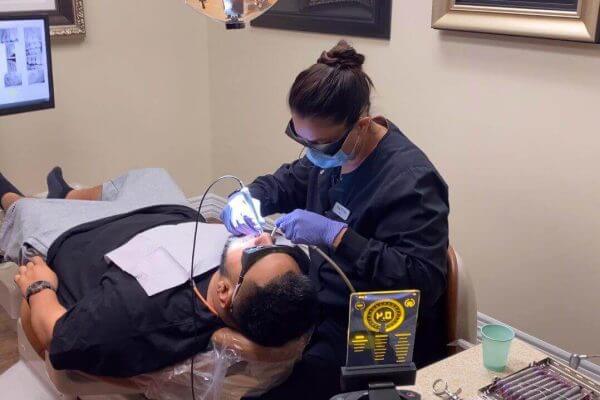Teeth Extraction Has Never Been More Comfortable
There was once a time when people dreaded visiting the dentist, and despite modern advances in technology, some patients still delay making appointments. But that’s starting to change as new techniques and safer anesthesia are making oral surgeries, like tooth extraction, more comfortable than ever.
If you have a persistent toothache or damage due to gum disease, it may be necessary to remove your tooth. This will prevent the spread of infection and help you reverse periodontitis. It’s best to act early, so don’t delay to schedule a visit with Dr. Derek Hauser at Lakefront Family Dentistry.
Dr. Hauser has 20 years of experience as a general dentist. His practice features the latest dental technology, including CEREC and the ORTHOPHOS XG 3D digital-imaging system.
If you’re looking for a family dentist in Riverside County, Contact Lakefront Family Dentistry at (951) 244-9495 or Request an Appointment Online Today!
Maximizing Comfort During Teeth Extraction
There are few treatments that are as jarring to patients as removing a tooth, but there are a few steps that dental practices can take to keep patients optimistic and pain free. At Lakefront Family Dentistry, our staff raises the bar on patient care by providing superior expertise and premium A-dec dental chairs.
Our team features three dental hygienists, so patients trust they’re in good, experienced hands right when they enter our office. After two decades in his field, Dr. Hauser mastered his craft and can provide a range of treatments, from attaching veneers and crowns to extracting teeth.
Patients receive a local anesthetic before the extraction begins. This prevents any discomfort but won’t inhibit your ability to drive home after the procedure.
Recovery time usually lasts only a few days. We’re always asked if there is anything patients can do to speed up recovery, so here are some helpful tips:
- Take mild painkillers to relieve any discomfort.
- Rinse your mouth with warm, salty water two to three times each day. Mix an 8-fluid ounce glass of water with 1 teaspoon of salt. This will relieve pain and reduce swelling.
- Replace gauze pads as instructed.
- Avoid physical or strenuous activity after surgery.
- Avoid smoking after surgery.
- Consume soft foods like pudding, gelatin or soup. Slowly add solid food to your daily diet.
- Avoid lying flat. This could increase bleeding. Also, keep your head propped up on pillows.
- Do not rub the area with your tongue.
- Continue to brush your teeth and tongue carefully.
If you relax for a few days after surgery and follow these tips, recovery from tooth removal should be a breeze. Then, you and Dr. Hauser can discuss replacement options, such as dental implants or a bridge.
Weighing the Options for Replacing a Missing Tooth
Removing an unhealthy tooth can be a smart and vital health decision. Infections can spread to the bone, other teeth or blood vessels. Periodontitis has been linked to disorders like dementia and heart disease, so it’s absolutely necessary that patients seek help for poor oral health.
Not only is teeth extraction fantastic for a person’s oral hygiene, but today, replacing a missing tooth is possible for just about anyone. With a bridge, implants or dentures, patients can enjoy a perfect smile, comfortable chewing and clear speaking, all of which would be compromised with missing teeth.
All of these options are long lasting. A dental implant, though, is perhaps the best treatment in terms of appearance and functionality. Unlike dentures, you can clean dental implants like your natural teeth, and you don’t need to remove them. Bridges require wiring, and although it’s nearly imperceptible, dental implants look almost identical to your natural teeth.
Dr. Hauser has 10 years of experience as a cosmetic dentist. If you need to replace missing, cracked or chipped teeth, schedule an appointment to discuss your goals.
Signs Your Might Need Tooth Removal
Only a dentist or oral-hygiene professional can tell you if removing a tooth is necessary. In many cases, a root canal can solve the problem.
The signs that you need tooth removal are indicative of late-stage gum disease. More than likely, you will have noticed some swelling, redness or tenderness of the gums near the infected tooth. Toothache is a common symptom. Bleeding can start, which opens your bloodstream to infectious bacteria.
If you notice any of these symptoms, schedule a dental exam right away. To find out if a tooth extraction procedure is the right treatment for you, Contact Lakefront Family Dentistry at (951) 244-9495 or Request an Appointment Online Today!






